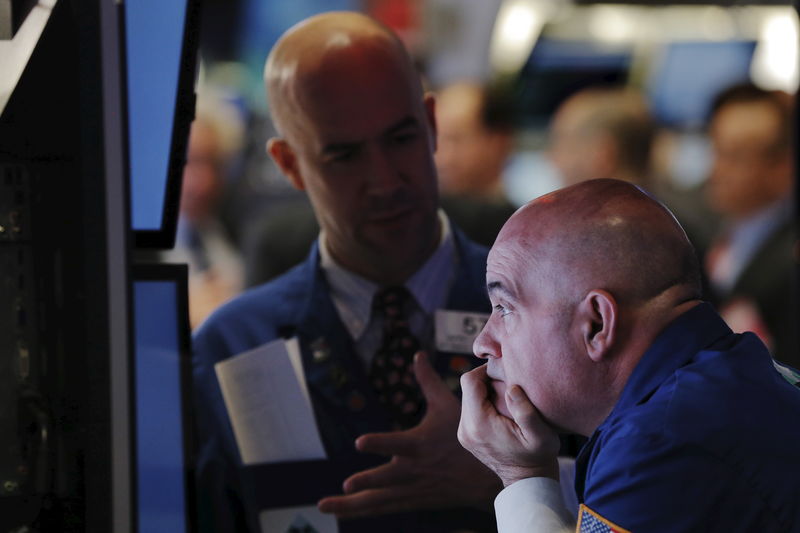Investing.com - Stocks plunged Wednesday after a key economic signal warned that the slowing global economy may produce a recession and both Germany and China showed more signs of slowing growth.
At the close, the S&P 500 fell 2.93%. The Nasdaq Composite and Dow were both down a little more than 3%. The Dow fell more than 800 points, its biggest one-day loss of the year and worst since Oct. 18, 2018, when the index fell nearly 832 points.
The emotional catalyst came early in the day when the yield on the 10-Year Treasury note briefly fell below that of the 2-Year Treasury for the first time since 2007. When the yield curve inverts, paying higher yields for shorter-term securities, it indicates that investors are not only moving out of stocks and into safer bonds, but that they are worried about short-term prospects and piling into longer-term debt.
The 10-year yield closed at 1.595%, while the 2-year yield was at 1.589%.
The market slump has seen the Dow fall 7% from its record high in July. The S&P is off 6.2% from its July peak and the Nasdaq is down 6.8%.
The market stress comes amid the backdrop of the continuing trade fight between the United States and China. The Trump Administration has imposed tariffs on a wide variety of goods and is set to impose more on Sept. 1. Another round is due on Dec. 15, which would include cell phones and other electronics and consumer goods. The tariffs have hit Chinese exports and forced a number of companies to search out new manufacturing sites outside China, mostly in Southeast Asia.
Meanwhile, China has retaliated against the U.S. with their own tariffs. In addition, China has shied away from buying some U.S. products, especially soybeans.
At the same time, slumping exports sent Germany's economy into reverse in the second quarter, while Chinese industrial output growth cooled to a more-than-17-year low in July.
Interest rates globally have fallen as the scope of the slowdown has emerged. The Federal Reserve cut its key interest rate on July 31 to 2% to 2.25% even as President Donald Trump bitterly bashed the central bank and called for much lower rates. His criticism continued Wednesday. The Fed is expected to cut rates again at its meeting in mid-September and in October, according to Investing.com's Fed Rate Monitor Tool.
None of the Dow stocks were higher, although Coca-Cola (NYSE:KO) and Walmart (NYSE:WMT), both classic defensive stocks, were off about 1%. Boeing (NYSE:BA), Apple (NASDAQ:AAPL), Goldman Sachs (NYSE:GS), JPMorgan Chase (NYSE:JPM) and 3M (NYSE:MMM) were the biggest contributors to the Dow's decline.
Boeing's 3.7% decline was worth 84 Dow points. Goldman Sachs, off 4.2%, subtracted 57 points from the index.
Facebook (NASDAQ:FB), Amazon.com (NASDAQ:AMZN), Cisco Systems (NASDAQ:CSCO) and Tesla (NASDAQ:TSLA) were all off at least 3%.
Cisco fell an additional 6% after hours after the guidance in its fiscal fourth-quarter earnings report disappointed Wall Street.
Only one stock in the Nasdaq 100 Index was higher on the day, Chinese internet company NetEase (NASDAQ:NTES) rose 0.5%. The index fell 3.1%.
The day was so bad that just three S&P 500 stocks showed gains on the day: Newmont Goldcorp (NYSE:NEM), Ventas (NYSE:VTR), a real-estate investment trust, and Midwestern utility company Evergy (NYSE:EVRG).
Energy, communications services (which includes Facebook and Google parent Alphabet (NASDAQ:GOOGL), and financial stocks were the weakest sectors, along with retailers, including Macy’s (NYSE:M) and Nordstrom (NYSE:JWN), both down more than 10%.
Real estate and utilities were only slightly lower because of falling interest rates.
Stocks globally were lower, with stocks in Germany and France off more than 2% and Brazil's Bovespa index down more than 3%.
Oil prices were lower, with West Texas Intermediate crude futures down $1.87 to $55.23 and gold futures settled up $13.70 to $1,527.80. Gold is up more than 6% in August and 19% on the year.
In seven of 11 trading days so far in August, the Dow has risen or fallen more than 275 points during the day. The violence and speed of moves up and down for the Dow, S&P 500 and Nasdaq this month is likely due to computer algorithms making split-second buying and selling decisions.
